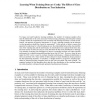Free Online Productivity Tools
i2Speak
i2Symbol
i2OCR
iTex2Img
iWeb2Print
iWeb2Shot
i2Type
iPdf2Split
iPdf2Merge
i2Bopomofo
i2Arabic
i2Style
i2Image
i2PDF
iLatex2Rtf
Sci2ools
CORR
2011
Springer
2011
Springer
Learning When Training Data are Costly: The Effect of Class Distribution on Tree Induction
For large, real-world inductive learning problems, the number of training examples often must be limited due to the costs associated with procuring, preparing, and storing the training examples and/or the computational costs associated with learning from them. In such circumstances, one question of practical importance is: if only n training examples can be selected, in what proportion should the classes be represented? In this article we help to answer this question by analyzing, for a fixed training-set size, the relationship between the class distribution of the training data and the performance of classification trees induced from these data. We study twenty-six data sets and, for each, determine the best class distribution for learning. The naturally occurring class distribution is shown to generally perform well when classifier performance is evaluated using undifferentiated error rate (0/1 loss). However, when the area under the ROC curve is used to evaluate classifier performa...
| Added | 19 Aug 2011 |
| Updated | 19 Aug 2011 |
| Type | Journal |
| Year | 2011 |
| Where | CORR |
| Authors | Foster J. Provost, Gary M. Weiss |
Comments (0)

